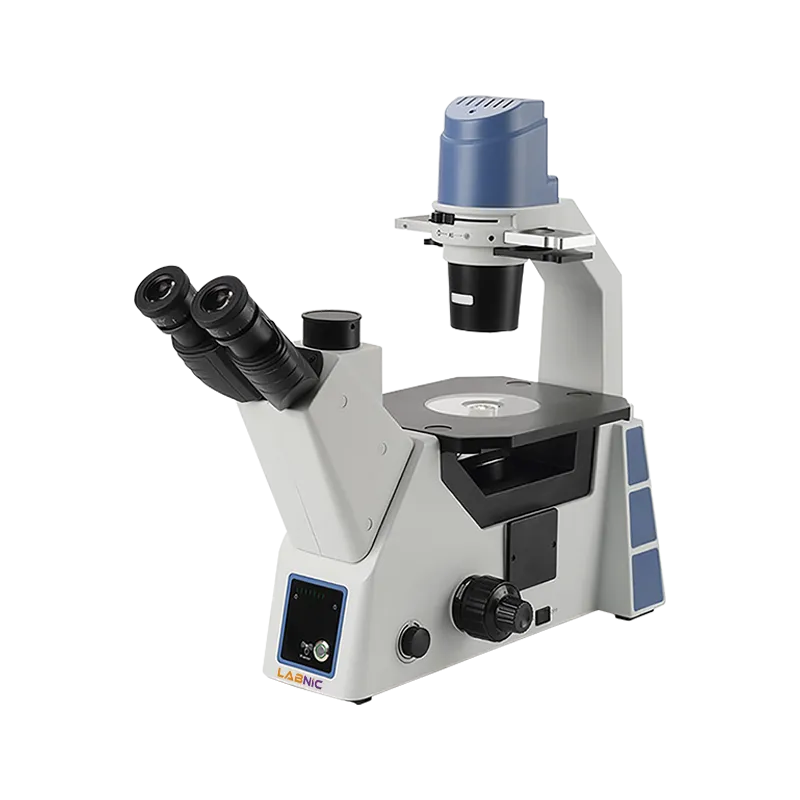
Inverted biological microscope LBN-IM121 comes with a combined bright field, dark field, phase contrast, fluorescent, DIC, and semi-apo optical system that is intended for laboratory biological study as well as industry metallurgical and geographic research. Its front-view information panel makes it easier to work in a dark environment by allowing you to see brightness, objective, and fluorescent filter conditions without having to look inside the microscope.
| Optical Type | Infinity Plan |
| Standard Magnification | 40x – 400x |
| Head Type | Siedentopf Trinocular |
| Inclination | 45° |
| Rotation | 360° |
| Interpupillary | 50-75mm |
| Light Path | E50:P50 |
| Diopter | Adjustable |
| Eyepiece Diameter | 30 mm |
| Eyepiece | Wide Field Plan PL10x/22 mm, High Point, Diopter Adjustable with Reticle |
| Nosepiece | 5 holes |
| Objective | Infinity LWD Plan Achromatic Objective 4x, 10x, 40x, Infinity LWD Positive Phase Contrast Objective 20x |
| Working Stage Type | Fixed Plain Stage |
| Stage Size | 215 × 250 mm |
| Moving | 120 × 78 mm |
| Focusing Range | 9 mm |
| Scale | 0.002 mm |
| Knob | Up 6.5 mm + Down 2.5 mm |
| Condenser | LWD 0.3 N. A, W.D 72mm, Dismountable, with Phase Contrast Slot |
| Light Source | LED |
| Transmit Light | 5W LED Illumination, Intensity Adjustable, LBD Color Temperature Change Filter Diameter 45 mm, IF550 Green |
| Power Supply | AC110V-220V |
| Phase Contrast | Centre-Adjustable Phase Contrast Slide Plate, for 4x 10 + 20x 40x objectives, centering telescope Diameter 30 mm |
| Dimensions (L × D × H) | 680 × 670 × 470 mm |
| Net Weight | 19 Kg |
| Gross Weight | 21 Kg |
Inverted Biological Microscope is used in fish, plant, animal, and poultry tissue culture laboratories as well as animal and plant laboratories.
Inverted Biological Microscope is used in fish, plant, animal, and poultry tissue culture laboratories as well as animal and plant laboratories.
Most Frequently Asked Questions
1. What is an Inverted Biological Microscope?
Ans. An Inverted Biological Microscope is designed for observing live cells, tissue cultures, and liquid samples from below, with the light source and objective lenses positioned beneath the stage.
2. What are the key applications of an Inverted Biological Microscope?
Ans. It is widely used in cell biology, microbiology, IVF research, pharmaceutical studies, and live-cell imaging for observing adherent cells, tissue cultures, and microorganisms.
3. What types of samples can be observed with an Inverted Biological Microscope?
Ans. It is suitable for adherent cells, tissue cultures, microorganisms, embryos, and aquatic specimens in liquid media.
4. Does an Inverted Biological Microscope require special objective lenses?
Ans. Yes, it uses long working distance (LWD) objective lenses, allowing focus through thick samples or liquid media.
5. What are the advantages of using an Inverted Biological Microscope?
Ans. It allows non-invasive live-cell observation, supports larger sample containers like flasks and petri dishes, and is compatible with advanced imaging techniques such as fluorescence and phase contrast.
Inverted biological microscope LBN-IM121 comes with a combined bright field, dark field, phase contrast, fluorescent, DIC, and semi-apo optical system that is intended for laboratory biological study as well as industry metallurgical and geographic research. Its front-view information panel makes it easier to work in a dark environment by allowing you to see brightness, objective, and fluorescent filter conditions without having to look inside the microscope.